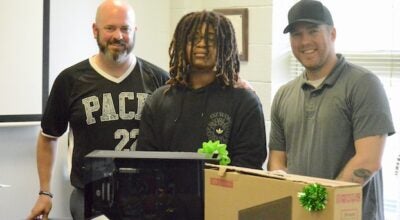N.C.’s monster black bears didn’t get that way be accident
Published 12:32 pm Tuesday, November 25, 2014
Many of us old timers remember the “haydays” of hunting black bears in eastern North Carolina. It seemed that there was a never-ending supply of these animals that roamed in the vast forests of the coastal counties. We also remember waking up one day to find the bears that seemed to always be there were no longer there. The bear hunters from the mountains of Tennessee, Virginia and South Carolina and their packs of very specialized bear hounds had about done our bears in.
Luckily, the North Carolina Wildlife Resources Commission had the foresight to begin to manage this particular type of big game animal and, with a lot of help from the very bear hunters who contributed to the decline of the black bear in our state, the North Carolina population of black bears has grown to the level it is at today. The bear management here is a shining example of how our wildlife managers in cooperation with the conservation-minded bear hunters brought our black bears back to their present levels. We’re known around the world for not only the numbers of bears in our state, but also for the immense size that these bears seem to grow to. One has to wonder just why our bears grow so big.
The Boone and Crockett Club (B&C Club) is the big game hunting club that keeps records for really trophy-sized animals. The ungulates, such as whitetail and mule deer, aren’t awfully hard to measure. In most cases, antler size is the criterion that the record keepers use to put the hunter’s kill in the record books. Bears, such as the grizzly and black bear, are measured differently. The B&C Club uses the skull size of these animals to classify their size and possible trophy status.
The state of North Carolina seems to use a different criterion to reference the relative size of our big black bears. They go by the total “live” weight of the animal that was killed not the skull size. In this case, “live weight” means that the bear is weighed before it is gutted and field dressed. In other words, even though the bear is deceased when it’s weighed, our N.C. records uses its “total” (live) weight as if it was still alive.
It’s been about 20 years since one of Dolly Parton’s cousins came down from the mountains of Tennessee and killed the 880-pound black bear in Craven County. The sport of bear hunting in our state was “riding high” with hunter’s interest all over the United States at that time and an 880-pound black bear made headlines. Hunters from other areas even thought that maybe the Craven County bear was a misplaced grizzly bear that had wandered into our state.
Attempts were made to have the Craven County North Carolina state record black bear (live weight record) registered with the B&C Club by measuring the skull and submitting these measurements to have it qualified as a record black bear. The skull was removed, dried and then registered with the B&C Club. Unfortunately, the final killing shot on this bear was carried out at close range with a 12-gauge shotgun loaded with a slug. The skull was severely damaged by the force of slug and, by the Boone & Crockett rules, a severely damaged skull cannot be registered for the record books. It is entirely possible that the Craven County bear could have been a world record had the skull not been so damaged.
While large, the Craven County record black bear isn’t the largest black bear that was ever killed by a hunter. As far as I can determine, the State of Pennsylvania Wildlife Department claims that the unofficial, estimated weight record was a 1000-pounder. Pennsylvania goes by the Boone & Crockett trophy measuring standards and this particular bear was measured by the skull-sizing method. With a skull measuring 23- 9/16 inches, the Pennsylvania black bear stands as the official world record black bear.
The Boone & Crockett Club’s measuring system is really more accurate in judging the relative size on black bears. Theoretically, a relatively young black bear of 10 or 11 years of age could have been simply a fat bear. Biologists feel that the bear’s skull grows as the bear grows older, much the same as a whitetail deer’s antlers grow with age (up to a point of course. A whitetail’s antlers actually decline in size as a really old buck grows older. Black bears also tend to decrease in condition as they age.).
As biologists attempted to find out why the Craven County bear grew so big, they found that this bear had been feeding heavily on hog carcasses in a waste bin near a hog farm. The fat pork probably added a lot of calories to the diet of this bear and added a lot of fat to an animal that is notoriously fat anyway. Some scientists now wonder if there might have been a lot more in that pork fat than we knew about at the time.
It’s a common practice for deer hunters in North Carolina to feed whitetail deer. The most common supplemental food that the hunters give to their pampered deer is shelled corn.
In recent years, many trophy deer hunters have been following the advice of the well-known wildlife biologist Dr. James Kroll. He’s examined a lot of our Tar Heel deer and found that in many instances the deer are infested with internal parasites. With that in mind, Dr. Kroll recommended that the hunters add 100-CCs of liquid Ivermectin (a broad-spectrum antiparasitic agent, traditionally used against parasitic worms) to every 100 pounds of shelled corn and treat the deer once every spring and once every fall. By keeping the deer relatively clear of internal parasites, the landowners/hunters could have healthier deer most of the year.
What wasn’t mentioned is black bears that eat the same feed and occupy the same habitat also eat the doctored corn and should also benefit from the medication. Like the deer, the bear should lead a much healthier life and, possibly, reach a much heavier weight than they normally do. Any animal prone to internal parasites such as raccoons, opossums and skunks that eats the treated corn could benefit from the Ivermectin. Many of us use the same Ivermectin on our household pets.
The 782-pound black bear that Virginian Thomas Capps killed recently in Hyde County was one very big black bear. Exactly how it attained such a huge weight will probably never be known. Obviously, the bear was well fed and healthy. Deer are routinely fed corn in that area and lots of corn in any animals diet tends to add fat. Weather or not the bear’s diet was doctored may never be known either and, really, it doesn’t matter. Thomas Capps is deservedly proud of his kill and, unless the “big’un” really had its head messed up as it met its end, the properly handled, dried and submitted bear could prove to be a new world’s record for black bear. I wish Mr. Capps the best.





